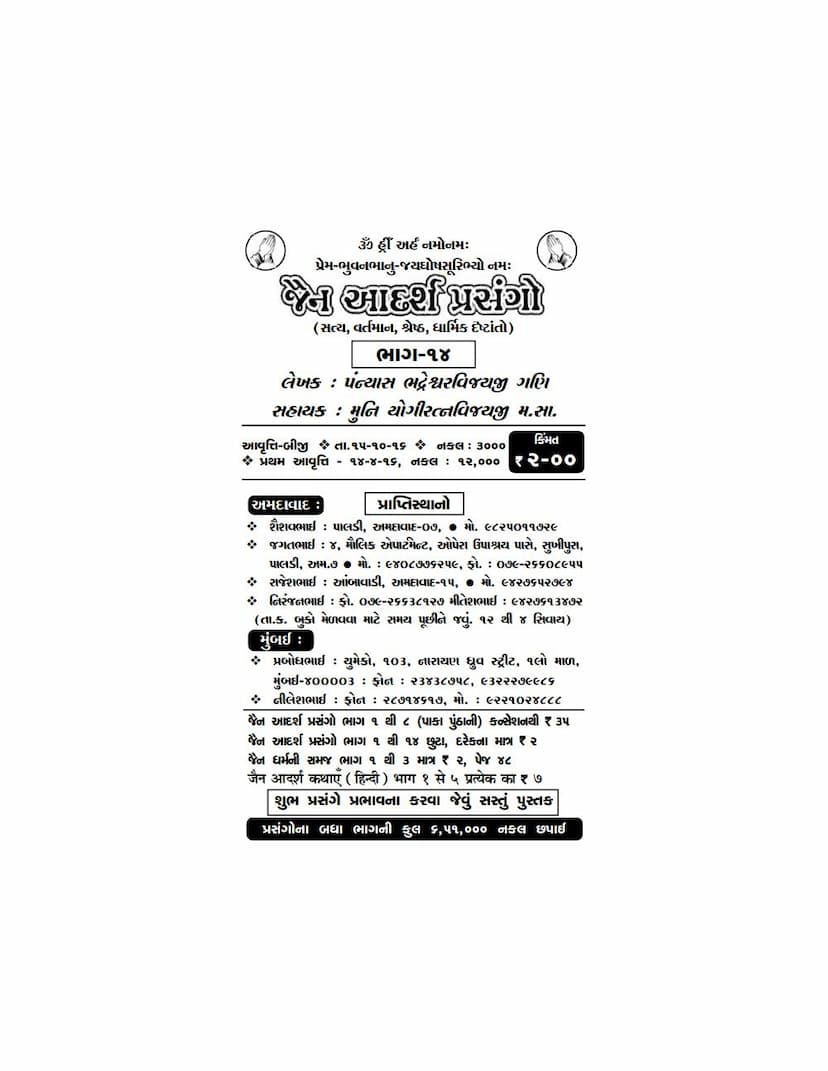Jain Adarsh Prasango Part 14
Added to library: September 1, 2025

Summary
Here's a comprehensive summary of "Jain Adarsh Prasango Part 14" by Bhadreshwarvijay, based on the provided text:
Overview:
"Jain Adarsh Prasango Part 14" is a collection of inspiring true stories and examples of devotion, adherence to Jain principles, and the power of faith and spiritual practices. The book aims to motivate readers by showcasing exemplary lives and actions in the current era, highlighting that the Jain faith continues to flourish even in challenging times. The author, Panyas Bhadreshwarvijayji Gani, assisted by Muni Yogiratna Vijayji M.Sa., presents these accounts to inspire spiritual growth and encourage adherence to Jain teachings.
Key Themes and Examples:
The book is structured around numerous individual stories, each illustrating different facets of Jain practice and philosophy. Here's a summary of the prominent themes and examples:
-
Devotion to the Tirthankaras and Spiritual Paths:
- Giriraj Yatra (Pilgrimage to Mount Shatrunjaya): Several stories emphasize the profound impact of pilgrimages. One story details a woman's desire for initiation (diksha) after witnessing a nun supporting her guru on Mount Shatrunjaya. Her deep longing leads her to request permission for diksha from her husband at the summit, which he grants due to divine grace and her pure intentions.
- The Power of Vows and Penance: A nine-year-old girl undertakes the strenuous "Chauvihar Chhath" (fasting from evening till the next morning) for seven pilgrimages, inspiring her father to build a temple at home. Another story highlights a man who, despite a severe leg injury, undertakes thirteen pilgrimages in three days through sheer faith and determination.
- "Buy One, Get Two Free" Principle in Spirituality: A family's decision to embrace the monastic path is driven by a profound spiritual realization following their son's near-death experience. This illustrates the transformative power of spiritual commitment.
-
The Efficacy of Mantras and Prayers:
- Navkar Mantra's Power: The book repeatedly emphasizes the efficacy of the Navkar mantra. One story describes how reciting the mantra helped a patient recover from a severe illness, surprising doctors. Another instance shows how a painful injury healed rapidly after chanting "Namo Siddhanam." The story of Khubu illustrates how the repeated chanting of the Navkar mantra and other sacred verses helped overcome obstacles in her spiritual practices and even led to the birth of a child.
- Other Mantras and Stotras: The text mentions the power of various Jain stotras like Uvasaggaharam, Shantikara, and Bhaktamar, suggesting their ability to resolve difficulties and bring about positive outcomes.
-
True Devotion and Sacrifice:
- The "99 Yatra" Challenge: The book features stories of individuals undertaking the difficult vow of 99 pilgrimages, often balancing their religious commitments with household responsibilities, demonstrating unwavering dedication.
- Anonymity in Charity: Many instances of selfless service and donations are highlighted, where individuals prefer to remain anonymous, emphasizing that true devotion is not for recognition.
- Sacrifice for Dharma: A mother's vow of continuous Ayambil (a specific type of fasting) until her son receives initiation, and her subsequent death, is presented as a powerful example of maternal sacrifice for spiritual advancement.
-
The Role of Gurus and Spiritual Guidance:
- The stories frequently mention the guidance and blessings of Jain monks and nuns (Gurus) in overcoming challenges and deepening spiritual practice. Their teachings and inspiration are pivotal in the characters' journeys.
-
Ethical Conduct and Purity:
- Modesty and Dress Code: A poignant story describes a devotee who stopped serving in the Ayambil kitchen due to discomfort caused by immodestly dressed female attendees, highlighting the importance of adhering to traditional values and respecting spiritual spaces.
- Honesty in Business: A hotel owner's commitment to not serving root vegetables (kandmool) and his efforts to offer Jain food to international tourists exemplify maintaining Jain principles even in business.
-
The Importance of Faith and Belief:
- The narratives consistently showcase that unwavering faith in Jain principles, mantras, and the teachings of the Tirthankaras can lead to miraculous outcomes and overcome seemingly insurmountable obstacles.
-
Community Service and Sponsorship:
- The "Prarthana Yuvak Mandal" is lauded for its extensive community service, including assisting pilgrims, managing temple offerings, and caring for animals.
- The example of the Nandurbar Sangh highlights their dedication to supporting the needy, providing facilities for pilgrims, and caring for animals.
-
Reverence for Jain Practices:
- Stories emphasize the significance of practices like "Vashikaran" (invoking divine presence through rituals), "Panchkalyanak Pratishtha" (consecration ceremonies), and "Navkaran" chanting.
- The concept of "Bhava Yatra" (mental pilgrimage) is presented as a powerful way to connect with holy sites, even for those physically unable to travel.
-
The Impact of Non-Jains on Jain Principles:
- One notable story details how a non-Jain landlord, Himanshubhai, wholeheartedly supported the Jain community during their Chaturmas, showcasing compassion and respect for religious practices, suggesting a potential path for spiritual awakening in others.
-
Ultimate Goal: Moksha (Liberation):
- Many stories implicitly or explicitly point towards the ultimate goal of Jainism: liberation from the cycle of birth and death. The devotion, penance, and ethical conduct are all directed towards this aim.
Publisher and Availability:
The book is published by Bhadreshwarvijay and is available from various Jain centers in Ahmedabad and Mumbai. The catalog link provided is https://jainqq.org/explore/008122/. The text mentions that over 6,51,000 copies of various parts of "Jain Adarsh Prasango" have been printed.
Conclusion:
"Jain Adarsh Prasango Part 14" serves as a valuable resource for Jain readers, offering a rich tapestry of real-life experiences that reinforce faith, inspire virtuous conduct, and highlight the enduring power of Jain principles and spiritual practices in contemporary life. The book encourages readers to emulate these exemplary lives and to cultivate a deeper connection with their faith.